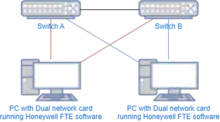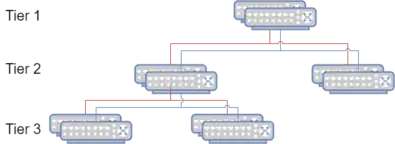| Communication protocol | |
| Purpose | network protocol |
|---|---|
| Developer(s) | Honeywell |
| Introduction | 2011 |
Fault Tolerant Ethernet (FTE) is proprietary protocol created by Honeywell. [1][2]

Designed to provide rapid network redundancy, on top of spanning tree protocol.[3] Each node is connected twice to a single LAN through the dual network interface controllers. The driver and the FTE enabled components allow network communication to occur over an alternate path when the primary path fails.[4][5]
Default time before failure is detected, is Diagnostic Interval (1000ms) multiplier with Disjoin Multiplier (3), for a 3000ms recovery time.
Similar to Switch Fault Tolerance (SFT) in windows and mode=1 (active-backup) in Linux.
Supported hardware and software
- Windows 7/2003 or newer
- Honeywell Control Firewall (CF9)
- Honeywell C300 Controller
- Honeywell Series 8 I/O
Technical overview

- Uses Multicast ( 234.5.6.7), for FTE community.
- Recommended maximum of 300 FTE nodes and 200 single connected Ethernet nodes (A machine with to network cards is considered as two separate single connected Ethernet nodes).
- Recommended to have separate broadcast/multicast domain , for different FTE communities.
- Recommended maximum of 3 tiers of switches.
- Default UDP Source Port: 47837
- Default UDP Destination Port : 51966
References
- ↑ "Fault Tolerant Ethernet". Honeywell Process Solutions. Retrieved 2019-05-25.
- ↑ "Technical Publications: Honeywell's Fault Tolerant Ethernet Guide". process.honeywell.com. Retrieved 2023-09-28.
- ↑ "Honeywell Fault Tolerant Ethernet and Control Firewall". The Automation Blog. 2021-04-23. Retrieved 2023-09-28.
- ↑ "Experion PKS". Honeywell Process Solutions. Retrieved 2019-05-25.
- ↑ "Experion PKS". Honeywell Process Solutions.
External links
- Honeywell Fault Tolerant Ethernet Page
- Jan Baranski; Marshall Crocker; Georgios Lazarou. "A Comprehensive Fault-Tolerant Ethernet-Based IP Network Design" (PDF). The Institute of Signal and Information Processing. S2CID 5280901.
This article is issued from Wikipedia. The text is licensed under Creative Commons - Attribution - Sharealike. Additional terms may apply for the media files.